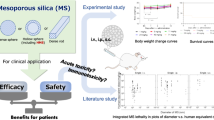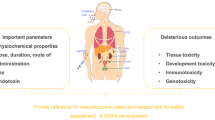Abstract
Background and objective: Microfabricated particles with nanosized features may serve an important role in the next generation of drug delivery vehicles. Microfabrication (micro-electromechanical systems) technologies offer the promise of both structural elements (e.g. pores, reservoirs) and electromechanical features (e.g. timers, valves, actuators) built into a single particle. In order to serve as carriers to deliver drugs to systemic sites of action, such as tumours, the particles must be safe to administer intravenously. An acute safety study was performed in a mouse model, using intravenous injection of solid silicon dioxide particles created to simulate the size and shape of potential targeted drug delivery vehicles.
Design: Two-micron thick, square and circular, parallelepiped-shaped particles were produced with varying sizes of 2μm, 5μm and 10μm using microfabrication techniques and injected into groups of mice (six mice per group) over a range of doses. End-points included acute lethality, clinical signs of toxicity and weight loss. Sections of major organs were sampled for histological examination.
Results: At dose levels of 1 × 108 particles per mouse, circular particles of 2μm and 5μm showed no signs of acute toxicity. Similar results were obtained with the 2μm and 5μm square silicon dioxide particles; however, 14-day necropsy indicates fewer 5μm circular particles in the lung than 5μm square particles, indicating that the shape of the particles may impact on safety. Acute lethality was observed for 10μm particles; none of the mice injected with the 10μm particles survived except at very low dose levels of 6 × 105 particles per mouse.
Conclusions: Solid silicon particles greater than 5μm in their largest dimension are cleared in the lungs and are not safe for intravenous delivery. Particles of 2–5μm in size do not lodge predominantly in the lung and do not cause acute toxicity, but accumulate in organs such as the liver and spleen. Possible chronic toxicities associated with organ uptake of such non-biodegradable particles have yet to be addressed.









Similar content being viewed by others
References
Ferrari M. Therapeutic microdevices and methods for making and using same. US Patent 6,107,102, 2000 Aug 22
Lewis J, Ferrari M. BioMEMS for drug delivery applications. In: van den Berg A, editor. Lab-on-a chip: miniaturized systems for (bio)chemical analysis and synthesis. Boston: Elsevier, 2003
Li X, St John J, Coffer JL, et al. Porosified silicon wafer structures impregnated with platinum anti-tumor compounds; fabrication, characterization, and diffusion studies. Biomed Microdevices 2000; 2 (4): 265–73
Martin FJ, Grove C. Microfabricated drug delivery systems: concepts to improve clinical benefits. Biomed Microdevices 2001; 3 (2): 97–109
Cohen MH, Melnik K, Boiarski AA, et al. Microfabrication of silicon-based nanoporous particulates for medical applications. Biomed Microdevices 2003; 5 (3): 253–9
Conhaim RL, Rodenkirch LA. Functional diameters of alveolar microvessels at high lung volume in zone II. J Appl Physiol 1998; 85 (1): 47–52
Acknowledgements
This study was funded by the National Cancer Institute under contract no. N01-C0-17043. All authors, except M. Ferrari, were employed by iMEDD, Incorporated, at the time of the study. iMEDD is potentially interested in commercialising the technology. M. Ferrari is the Scientific Founder of iMEDD and has a financial interest in the company.
Author information
Authors and Affiliations
Corresponding author
Rights and permissions
About this article
Cite this article
Martin, F.J., Melnik, K., West, T. et al. Acute Toxicity of Intravenously Administered Microfabricated Silicon Dioxide Drug Delivery Particles in Mice. Drugs R D 6, 71–81 (2005). https://doi.org/10.2165/00126839-200506020-00002
Published:
Issue Date:
DOI: https://doi.org/10.2165/00126839-200506020-00002




